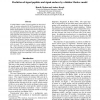Free Online Productivity Tools
i2Speak
i2Symbol
i2OCR
iTex2Img
iWeb2Print
iWeb2Shot
i2Type
iPdf2Split
iPdf2Merge
i2Bopomofo
i2Arabic
i2Style
i2Image
i2PDF
iLatex2Rtf
Sci2ools
ISMB
1998
1998
Prediction of Signal Peptides and Signal Anchors by a Hidden Markov Model
A hidden Markov model of signal peptides has been developed. It contains submodels for the N-terminal part, the hydrophobic region, and the region around the cleavage site. For known signal peptides, the model can be used to assign objective boundaries between these three regions. Applied to our data, the length distributions for the three regions are significantly different from expectations. For instance, the assigned hydrophobic region is between 8 and 12 residues long in almost all eukaryotic signal peptides. This analysis also makes obvious the difference between eukaryotes, Gram-positive bacteria, and Gram-negative bacteria. The model can be used to predict the location of the cleavage site, which it finds correctly in nearly 70% of signal peptides in a cross-validated test--almost the same accuracy as the best previous method. One of the problems for existing prediction methods is the poor discrimination between signal peptides and uncleaved signal anchors, but this is substant...
| Added | 01 Nov 2010 |
| Updated | 01 Nov 2010 |
| Type | Conference |
| Year | 1998 |
| Where | ISMB |
| Authors | Henrik Nielsen, Anders Krogh |
Comments (0)

